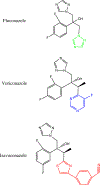Widespread Lichtheimia Infection in a Patient with Extensive Burns: Opportunities for Novel Antifungal Agents
- PMID: 29967971
- PMCID: PMC6445638
- DOI: 10.1007/s11046-018-0281-6
Widespread Lichtheimia Infection in a Patient with Extensive Burns: Opportunities for Novel Antifungal Agents
Abstract
The Mucorales fungi-formerly classified as the zygomycetes-are environmentally ubiquitous fungi, but generally rare causes of clinical infections. In the immunocompromised host, however, they can cause invasive, rapidly spreading infections that confer a high risk of morbidity and mortality, often despite surgical and antifungal therapy. Patients with extensive burn injuries are particularly susceptible to skin and soft-tissue infections with these organisms. Here, we present a case of Lichtheimia infection in a patient with extensive full-thickness burns that required significant and repeated surgical debridement successfully treated with isavuconazole and adjunctive topical amphotericin B washes. We also review the available literature on contemporary antifungal treatment for Lichtheimia species and related Mucorales fungi.
Keywords: Absidia; Burn; Isavuconazole; Lichtheimia; Mucorales.
Conflict of interest statement
Figures



Similar articles
-
Primary cutaneous mucormycosis in a patient with burn wounds due to Lichtheimia ramosa.Mycopathologia. 2014 Oct;178(3-4):291-5. doi: 10.1007/s11046-014-9805-x. Epub 2014 Aug 29. Mycopathologia. 2014. PMID: 25168130
-
Breaking the Mold: A Review of Mucormycosis and Current Pharmacological Treatment Options.Ann Pharmacother. 2016 Sep;50(9):747-57. doi: 10.1177/1060028016655425. Epub 2016 Jun 15. Ann Pharmacother. 2016. PMID: 27307416 Review.
-
Cutaneous Mucormycosis by Saksenaea vasiformis: An Unusual Case Report and Review of Literature.Mycopathologia. 2019 Feb;184(1):159-167. doi: 10.1007/s11046-018-0249-6. Epub 2018 Jul 30. Mycopathologia. 2019. PMID: 30062390 Review.
-
Isavuconazole in a Successful Combination Treatment of Disseminated Mucormycosis in a Child with Acute Lymphoblastic Leukaemia and Generalized Haemochromatosis: A Case Report and Review of the Literature.Mycopathologia. 2019 Feb;184(1):81-88. doi: 10.1007/s11046-018-0287-0. Epub 2018 Jul 23. Mycopathologia. 2019. PMID: 30039238 Review.
-
Real-time polymerase chain reaction detection of Lichtheimia species in bandages associated with cutaneous mucormycosis in burn patients.J Hosp Infect. 2018 May;99(1):68-74. doi: 10.1016/j.jhin.2018.02.004. Epub 2018 Feb 9. J Hosp Infect. 2018. PMID: 29432820
Cited by
-
Risk Assessment for Molds in the Vicinity of a Child Requiring Peritoneal Dialysis Living in a Rural Northern German Area.Microorganisms. 2021 Nov 4;9(11):2292. doi: 10.3390/microorganisms9112292. Microorganisms. 2021. PMID: 34835418 Free PMC article.
-
Use of isavuconazole in mucormycosis: a systematic review.BMC Infect Dis. 2025 Jan 6;25(1):25. doi: 10.1186/s12879-025-10439-y. BMC Infect Dis. 2025. PMID: 39762765 Free PMC article.
-
Rare multi-fungal sepsis: a case of triple-impact immunoparalysis.Folia Microbiol (Praha). 2024 Aug;69(4):903-911. doi: 10.1007/s12223-024-01165-0. Epub 2024 Apr 22. Folia Microbiol (Praha). 2024. PMID: 38647991
-
Necrotizing Mucormycosis of Wounds Following Combat Injuries, Natural Disasters, Burns, and Other Trauma.J Fungi (Basel). 2019 Jul 4;5(3):57. doi: 10.3390/jof5030057. J Fungi (Basel). 2019. PMID: 31277364 Free PMC article. Review.
-
Angioinvasive mucormycosis in burn intensive care units: A case report and review of literature.World J Crit Care Med. 2024 Mar 9;13(1):86866. doi: 10.5492/wjccm.v13.i1.86866. eCollection 2024 Mar 9. World J Crit Care Med. 2024. PMID: 38633476 Free PMC article.
References
-
- Kaur R, Bala K, Ahuja RB, Srivastav P, Bansal U. Primary cutaneous mucormycosis in a patient with burn wounds due to Lichtheimia ramosa. Mycopathologia. 2014;178:291–5. - PubMed
-
- Riley TT, Muzny CA, Swiatlo E, Legendre DP. Breaking the mold: a review of mucormycosis and current pharmacological treatment options. Ann Pharmacother. 2016;50:747–57. - PubMed
-
- Farmakiotis D, Kontoyiannis DP. Mucormycoses. Infect Dis Clin North Am. 2016;30:143–63. - PubMed
Publication types
MeSH terms
Substances
Grants and funding
LinkOut - more resources
Full Text Sources
Other Literature Sources
Medical

